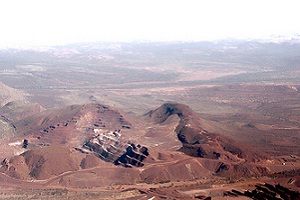
Scientists at Curtin University have chronicled the genesis of a particular type of iron deposit in the state’s north, finding that the valuable mineral formed relatively late in Western Australia’s evolution.
The researchers, along with the CSIRO, examined channel iron deposits (CID) taken from the Hamersley Province in the Pilbara to clarify the long running debate over how the deposits were created.
They used the dating technique (U–Th)/He in combination with other analytical methods to date the CID mineral, which is an iron-rich fluvial deposit formed in ancient river channels that is found almost exclusively in Western Australia.
John de Laeter Centre for Isotope Research director Brent McInnes says they wanted to determine when and how channel iron deposits (CID) formed during the geological evolution of Western Australia.
Professor McInnes says mining these iron formations, which supply 40 per cent of the country’s iron ore, is a cornerstone of the Australian economy and makes up approximately 20 per cent of national exports.
The team applied the dating technique to two CID samples which were taken from diamond drill cores and provided to the CSIRO by Robe River Mining from its Mesa J project.
“CID deposits are geologically ‘young’ deposits that formed continuously from about 26 million years ago to as recent as two million years ago,” Prof McInnes says.
“Considering that the bulk of Australia’s mines are located in rocks nearly 1,000 times older, the fact that Australia’s economy depends on a relatively recent geological episode is interesting.”
Tests revealed that environmental conditions conducive to CID formation existed during the Miocene period (23-5.3 million years ago) and that a typical Robe River CID sequence took roughly 4-8 million years to accumulate.
“Another interesting finding is that the Pilbara was much wetter 20 million years [ago], and supported substantive tree-lined, slow-moving water courses and drainage networks,” Prof McInnes says.
“The iron-rich sediments accumulated at the bottom of these ancient river channels over tens of millions of years, indicating that the drainage networks were long-lived.”
Curtin researcher and study co-author Associate Professor Noreen Evans developed the U-Th/He dating technique which measured minute levels of uranium and thorium and which together experiences radioactive decay at a constant rate and produces helium as a by-product.
The scientists then measured concentrations of each element in iron-rich minerals in the iron formations using sensitive mass spectrometry techniques and from that analysis they calculated the time it took for the helium to accumulate via radioactive decay.
They will now apply the technique to try and understand the weathering history of Australia by examining iron-oxide minerals in oxidised lateritic assemblages.
Note : The above story is based on materials provided by Science Network WA










